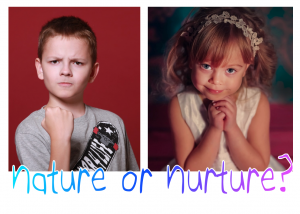
Where does a child get its sense of gender?
 There are certainly some biological differences between girls and boys. Firstly, girls have XX chromosomes and boys have XY, except in very rare intersex conditions. You cannot change your chromosomes. It doesn’t matter if you like princesses or pirates, if archaeologists dig up your bones in two hundred years time, they’ll be able to tell if you were a man or a woman. It’s in your DNA. Girls and boys are born not only with different genitalia but with different hormone levels. But as the nature/nurture debate rages I become more and more convinced that boys and girls would have far fewer differences if we stopped shoving them into pink and blue boxes.
There are certainly some biological differences between girls and boys. Firstly, girls have XX chromosomes and boys have XY, except in very rare intersex conditions. You cannot change your chromosomes. It doesn’t matter if you like princesses or pirates, if archaeologists dig up your bones in two hundred years time, they’ll be able to tell if you were a man or a woman. It’s in your DNA. Girls and boys are born not only with different genitalia but with different hormone levels. But as the nature/nurture debate rages I become more and more convinced that boys and girls would have far fewer differences if we stopped shoving them into pink and blue boxes.
A study conducted by the University of Indiana reported that there is no difference in the athletic abilities of pre-pubescent children. They analysed the data of nearly two million swims and found that there was no difference in performance between boys and girls aged eight, and only little difference until the teenage years when puberty kicked in.
“The typical girl is slightly shorter than the typical boy at all ages until adolescence. She becomes taller shortly after age 11 because her adolescent spurt takes place two years earlier than the boy’s. At age 14 she is surpassed again in height by the typical boy, whose adolescent spurt has now started, while hers is nearly finished. In the same way, the typical girl weighs a little less than the boy at birth, equals him at age eight, becomes heavier at age nine or 10, and remains so until about age 141/2.”
Encycolpædia Britannica
So the physical differences between pre-pubescent boys and girls are slight.
What about the psychological and temperamental differences?
Are boys really naturally inclined to be louder, more boisterous, more physical and aggressive and girls to be empathic, calm, creative and compliant?
While we certainly see some differences in behaviour, it is hard to tell to what extent they are biological or cultural- because we start gendering our children before they are born.
Think I’m exaggerating?
One Twitter user told me: “The Sonographer joked at our daughter’s scan that she must be a girl because it looked like she was talking a lot”.

I recently watched an episode of Marie Kondo’s show (well obviously, anything rather than actually tidy up). It featured a couple who were expecting their first child and, as they watched it move on a scan, they joked that the baby was ‘flexing like daddy’. My ears pricked up right away and yes, the audience was shortly informed that their baby was indeed a boy.
While there is no reason whatsoever why a girl foetus might not flex just as effectively as her male counterpart, nor a boy foetus be preparing for a life of verbosity, we ascribe these often erroneous notions of gendered behaviour to our offspring from a time before they have even taken their first breath.
The small differences that genuinely exist between boys and girls at birth become amplified over time, as society, teachers and parents- often unintentionally- reinforce gender stereotypes.
One study showed that mothers of new born boy babies tended to describe them as ‘stronger’ although there was nothing to suggest this was the case. Another showed that when mothers estimated their babies’ ability to crawling down slopes, mothers of girls underestimated their performance and mothers of boys overestimated their performance. This bias had no basis in fact. Girls and boys achieve early motor milestones such as reaching, sitting, crawling and walking at roughly the same ages.
So where do small children get a sense of gendered behaviour?
Dressing the Gendered Child
I decided to visit a large Primark store and photograph the children’s clothing there. The following photos were all taken on the same day. Here are some of the boy’s clothes.
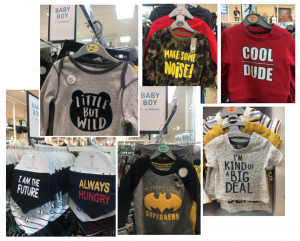
And here are some of the girls’ clothes.
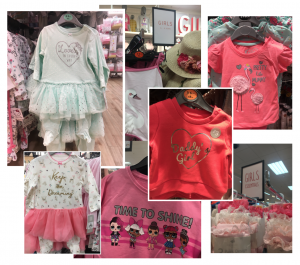
The ‘little but wild’ boy-child is ‘kind of a big deal’. He is a ‘cool dude’ who knows how to ‘make some noise’ and he is ‘ always hungry’. ‘Mummy’s little superhero’ is raised knowing ‘I am the future’.
‘Daddy’s girl’ is ‘pretty like mummy’. She is ‘lovely all the time’ and will ‘keep on dreaming’ until her ‘time to shine’. According to Primark, frilly laced socks are ‘essentials’ for a girl, and to top it all the kid is expected to nap comfortably in a babygro with a fucking tutu attached to it!
And if that’s not enough, here are some swimwear options.
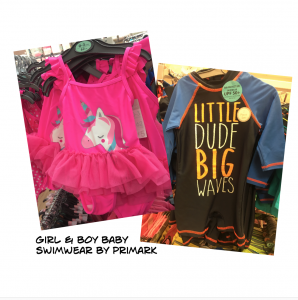
Socialising the Gendered Child
Outside home life, clubs and school, a child’s reading matter plays a big part in their socialisation. For every issue of First News or Aquila there are a score of lesser publications. Think The Economist and New Scientist surrounded by copies of lads mags and Cosmo. Check out the magazine shelves in your local newsagents. I went to a nearby Tesco, the same day that I visited Primark, to see what was on offer.
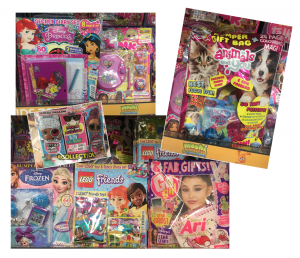 Here are the girls’ magazines. They are pastel shades of pink, purple and baby blue, adorned with sparkles and a sprinkle of friendship and caring; the free gifts are cheap plastic jewellery, shiny secret notebooks and endless unicorn stickers. This week I saw no make up or nail polish, but it is not an uncommon free gift with these magazines.
Here are the girls’ magazines. They are pastel shades of pink, purple and baby blue, adorned with sparkles and a sprinkle of friendship and caring; the free gifts are cheap plastic jewellery, shiny secret notebooks and endless unicorn stickers. This week I saw no make up or nail polish, but it is not an uncommon free gift with these magazines.
Animals and You magazine (far right) embraces a plethora of pink hearts and sparkly wrapped flying horses. Why? It’s a magazine about animals! How many boys look longing at the cover but never dare ask for it, having received the message loud and clear that a love of cute kittens is strictly for the girls?
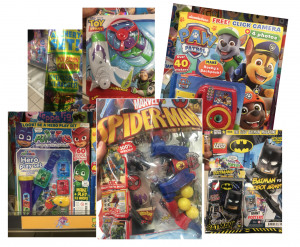 The boys’ magazines are bold in primary colours. The covers promise adventure and heroism inside; there are robot armies to be vanquished and villains to be thwarted; free gifts are badges and ‘epic’ puzzles but mostly gun-like apparatus for shooting frisbees or sponge balls.
The boys’ magazines are bold in primary colours. The covers promise adventure and heroism inside; there are robot armies to be vanquished and villains to be thwarted; free gifts are badges and ‘epic’ puzzles but mostly gun-like apparatus for shooting frisbees or sponge balls.
Paw Patrol magazine (far right) has removed the one female character from the line up on its cover. Presumably the publishers were worried about putting the boys off, because in the same way that kittens are for the girls, action and adventure is strictly for the boys.
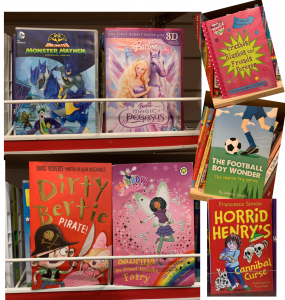
Books and DVDs do not fare much better. I checked out what was on sale in my local charity shop.
Again and again, it’s the story of the fairy and the superhero, the princess and the pirate.
Drip. Drip. Drip.
Horrid Henry breaks the cannibals’ curse! Dirty Bertie the pirate brandishes his cutlass; monsters create mayhem and football stars are made.
Barbie tosses back her hair as she poses with Pegasus, Sabrina the fairy spreads the gift of sweet dreams and the ‘Best Friends Club’ share stories of ‘crushes and blushes’.
Drip. Drip. Drip.
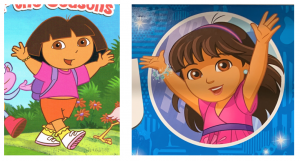
Dora in 2004 and Dora in 2019
And, excuse my Spanish, what the very fuck have they done to Dora the Explorer? Dora was a firm favourite of my older kids. With her short bobbed haircut and her little pot belly, she took no nonsense from anyone and was fazed by nothing. Now she has long hair and a Colgate smile and she’s wearing a V-necked dress and earrings.
Of course, girls can choose to ask for magazines from the ‘boys’ section. My older kids were obsessed with Ben 10 and smallest has a boy friend who will happily peruse the pages of Animals and You. These days the ‘boys’ and ‘girls’ sections of toyshops are rarely marked as such, although a quick glimpse tells kids who ‘belongs’ where. Girls, if you’re expected to like it, it’s probably available in pink.
The less conventional choices are harder for the less confident child; the child who values the importance of playing the gender game even if it leaves them feeling uncomfortable.
Ask yourself what might happen when that child is introduced to the GIRES penguins, to Introducing Teddy and to I Am Jazz? What happens when the child is led to believe that their choice in clothing or magazines might – just might- mean they were actually born the ‘wrong’ sex?
Celebrating the Gendered Child
Ever tried to find a birthday card for a girl that had a football on it? I popped into the newsagent where I top up my Oyster card and had a look at the cards on display. Happy birthday, Gendered Child.
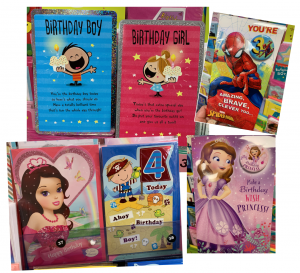
Pink, pink, pink. Hearts and flowers, trinkets and corsets, frills and tiaras, that’s what little girls are made of. Make a wish, Princess. Meanwhile, the pirate has found the treasure and go Spiderman, but I’d love to see a birthday card that told a girl she was ‘amazing, brave and clever’. As for the two cards top left, both offer advice. The boy is told to ‘have a brilliant time that’s fun the whole day through’ and the girl is advised to ‘put your favourite outfit on and give us all a twirl’.
Cleaning the Gendered Child
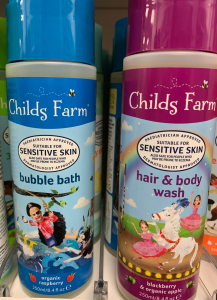
I think that’s probably enough now, don’t you?
Let Toys be Toys
Although I haven’t dealt with toys in this piece – that subject really needs an article all of it’s own – I was inspired to write this after seeing an announcement by an organisation I’ve always admired, Let Toys Be Toys (LTBT). LTBT has always fought to break down the stereotypes surrounding children’s toys, to discourage gendered packaging and ‘boy’ and ‘girl’ sections in toy shops.
“Children should feel free to play with the toys that most interest them. Isn’t it time that shops stopped limiting children’s imagination by telling them what they ought to play with?”
LTBT website
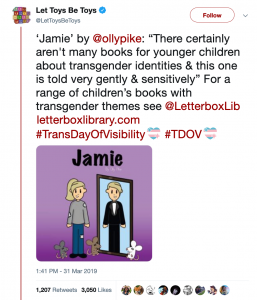
So imagine my surprise when LTBT made this announcement on Twitter a few days ago.
It stopped me dead in my tracks. Had their account been hijacked? By the time the Tweet was visible to many of us, it was April Fools Day – was it a rather tasteless joke?

A few hours later Let Toys be Toys posted another Tweet, this time claiming there was no one way or right way to be a girl.
Yet at the same time they were defending their earlier Tweet, commenting, “Let Toys Be Toys has supporters with a range of views on gender, but crucially we unite behind the message that narrow stereotypes are bad for everyone.”
It all sounds very nice, but you can’t have it both ways. It doesn’t make sense.
Let Toys Be Toys, for years you’ve been telling kids that boys and girls should not be defined by the books and toys they like playing with, the clothes they wear or the games and hobbies they enjoy, and bravo for that. Now – BAM – you’re telling them that it isn’t their biology that makes them a boy or a girl either.
So when you say there’s no right way to be a girl – presumably you now believe that being a boy can also be included in that?
Where does a child get its sense of gender?
Let Toys Be Toys, please answer me this: where does a small child get its sense of gender, if not from social experiences?
How can you possibly have a transgender child without stereotypes?
Who has got to you, or infiltrated your organisation: who is making you betray the very principles LTBT was founded on?
I don’t really expect an answer.
I never thought I’d see the day when Mermaids and Let Toys Be Toys were playing for the same side.
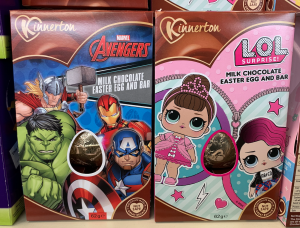
Happy Easter, Gendered Child.

Pingback: A criança generizada - QG Feminista